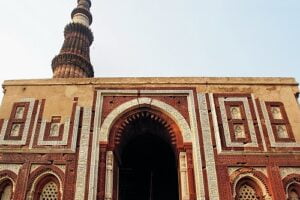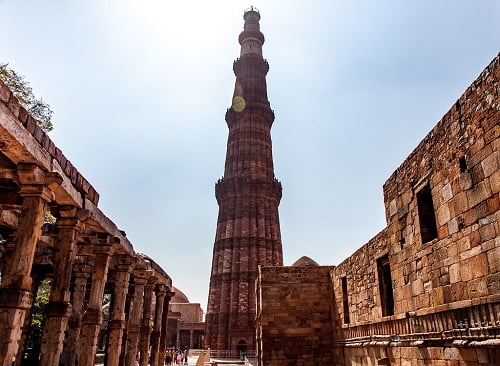The Qutb Minar Complex, a historic site, is located at Mehrauli in Delhi, India. The complex is an architectural ensemble that comprises a collection of monuments mainly from the Delhi Sultanate period. Each monument tells the history of different dynasties and proudly displays their architectural brilliance. This historic site contains various Mosques, Minarets, tombs, and so on. Among those, the Qutb Minar is the most popular one. In 1993, the ‘Qutb Minar and its monuments’ (the Qutb Minar Complex) was declared as a UNESCO World Heritage Site.
Notable Monuments within the Qutb Minar Complex:
Qutb Minar:

The Qutb Minar, a historic minaret, stands as both a symbol of India’s rich heritage and the dawn of Muslim rule in India. The founder of the Delhi Sultanate, Qutb-ud-din Aibak, started the construction of Qutb Minar in 1199 AD. Later, his successor Shamsuddin Iltutmish completed the construction. Further, Various rulers including Firuz Shah Tughlaq, Sikandar Lodi, and Sher Shah Suri repaired and reconstructed it multiple times.
Earlier, Qutb-ud-din Aibak was a general of the Ghurid emperor Muhammad Ghori. Some evidence states that Aibak built this 239-foot tall minaret as a ‘Victory tower’ to celebrate emperor Ghori’s victory over the Rajputs. Under the supervision of Muslim architects Hindu laborers constructed this minaret. This resulted in a fusion of Hindu and Islamic architectural styles in the construction. They used red sandstone and marble in this construction. As it rises, the Qutb Minar tapers from a 47-feet base to a 9-feet top.
It consists of 5 distinct storeys with projecting balconies and a total of 379 steps to access the top. The lowest storey showcases intricate architectural details, including pilasters, Muqarnas corbels, and inscriptions in naskh calligraphy. On the other hand, the top storey offers an amazing view of the area.
The Qutb Minar was constructed simultaneously with the Quwwat-ul-Islam mosque. According to an Arabic inscription, this minaret was possibly designed as a spot for the muezzin to call people for namaz.
Quwwat-ul-Islam Mosque:

The Quwwat-ul-Islam, which means ‘Might of Islam’, is one of the oldest surviving mosques in India. Another name of this mosque is ‘Qutub Mosque’ or ‘the Great Mosque of Delhi’. This mosque was the very first one constructed in Delhi after the Islamic conquest. In 1193 AD, Qutb-ud-din Aibak began this construction to make a mark for his religion in the new territory. Further, Sultan Iltutmish and Alauddin Khalji (ruler of the Khalji dynasty) made many extensions and additions to the mosque.
The construction of this Jami Masjid reflects a mix of architectural styles, including influences from the temples. The mosque has a courtyard with columns and a prayer hall with unique arches. The variations in the arch pattern indicate the Corbel style architecture. The screen of the mosque depicts various religious writings and floral designs.
According to the ASI, the mosque was built over the remains of a temple. Additionally, materials from other demolished temples were used in the construction. The main eastern entrance of this Jami Masjid also recorded this information.
Alai Darwaza:

In 1311 AD, Sultan Ala-ud-din Khalji built the main gateway to the mosque, which is known as the Alai Darwaza. He was the second ruler of the Khalji dynasty. Alai Darwaza serves as the primary entrance from the southern side of the Qutub Mosque. This is the first structure in India to adhere to true Islamic architectural principles. Decoration with red sandstone and intricate white marble designs makes the gateway look more attractive. In addition, we can find inscriptions in Naskh script on it, along with latticed stone screens.
Alai Minar:

After expanding the Quwwat-ul-Islam Mosque, Sultan Ala-ud-din Khalji planned to build another minar. He wanted to build the minar in proportion to the enlarged mosque. But, he completed only the first 82 feet high core of the minar during his time. After his death, his successors did not continue the construction. Unfortunately, the construction is still incomplete. The first storey of this minar remains today and is known as the Alai Minar. Amir Khusro’s Tarikh-i-Alai states the intentions of Ala-ud-din to extend the mosque and build another minar.
Iron Pillar:

The Iron Pillar is one of the oldest metallurgical wonders in the world. The pillar is around 7.21 meters tall and weighs about 6511 kg. Iron Pillar was first installed by Chandragupta II around 402 AD. Formerly, it was situated in front of a Vishnu temple at Udaygiri. Later (around 1052 AD), Anangpal II brought the pillar and fixed it in the Qutb complex. The 4th century Sanskrit inscription on the Iron pillar suggests that it was set up as a symbol of the god Vishnu, in memory of a mighty king named Chandra. This king is believed to be King Chandragupta II.
Apart from the above-mentioned structures, the complex is home to numerous other monuments of great significance. The monuments such as the Tomb of Iltutmish, Tomb of Imam Zamin, and Tomb of Ala-ud-din Khalji, each hold their unique historical importance.
Now, the Qutb Minar Complex has become a popular tourist destination. Now Archaeological Survey of India (ASI) manages this site. The annual festival, named ‘Qutub festival’ is celebrated here in November-December. In this festival, artists, musicians, and dancers perform over three days. Thus, The Qutb Minar Complex is a place where the history and culture of India harmoniously come together.

